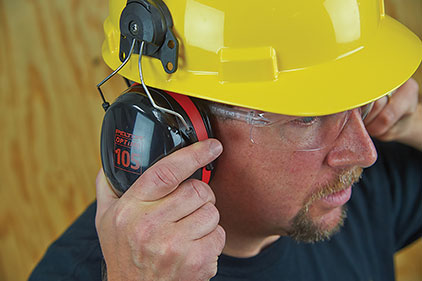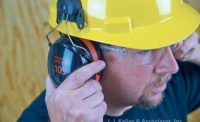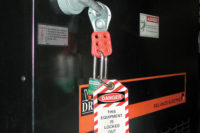What drives hearing protection compliance?
Motivate your workers to wear HPDs

Equipment selection
There are a few things you can do when you select the equipment to help ensure employees wear their HPDs. First, consider brightly-colored HPDs. There are many options available. If the color contrast is easy to see, you’ll be able to tell at a distance if someone is wearing earplugs. Another tip is to select corded plugs. It’s very easy to see a corded set of earplugs draped around a worker’s neck instead of in his ears.
Bright, corded earplugs help you spot noncompliance, and workers don’t want to get caught breaking a rule; but your goal is acceptance. To help attain that, be sure to select HPDs that are comfortable. HPDs that hurt won’t be worn. One factor in comfort is sizing. Everyone has a different size and shape to the ear canal, and one-size-fits-all earplugs don’t always fit everyone. Options are available in different sizes and shapes. Give your employees enough choice when fitting earplugs.
|
Similarly, not everyone has the same size ears and head. Ear muffs are adjustable, but a model that fits one worker comfortably may not fit someone else. Pay special attention to workers at the size extremes. Try several models to find HPDs for all sizes and shapes.
In addition to size and comfort, personal preference can make the difference between willingly wearing HPDs and taking them off when no one will notice. A variety of choices can help feed the need for personal preference.
Availability
Convenience drives compliance, too. What do your workers have to go through to get replacement HPDs? Having supplies readily accessible in work areas will encourage employees to wear HPDs. Having to go to the safety manager’s or supervisor’s office or fill out a requisition form will not.
Consider having earplug dispensers in the work areas and break rooms. Put up posters or signs to remind workers to get plugs when they enter the noisy area.
You want to provide a quick turnaround on repairs to earmuffs or provide replacement muffs as soon as an employee reports defective equipment. A worker already isn’t thrilled to have to turn in damaged equipment, but obstacles to getting replacements will only encourage the continued use of broken HPDs.
Be sure employees understand how and where to get HPDs when you initially fit them and during annual training.
Employee respect
Everyone responds better when they’re treated like an adult. Let your employees have some control over certain aspects of the program. For example, let employees help you decide on where to put HPD supplies in the work area. A month or two after you start your program, conduct an employee survey to get feedback on the HPD you’ve selected. And make changes based on the survey results.
Your training program should be interesting and conducted at a time and place that considers trainees’ workloads and schedules. Perhaps offer several sessions and let each worker select his own class time. Ensure the training content doesn’t “talk down to” the employees, but be cognizant of the workers’ level of education, literacy and language. The training must be understandable, but it won’t be effective if it leaves the audience feeling belittled. The trainees will learn more, and be more compliant with the program, when the training program honestly honors their willingness to take the time to learn.
Along with this, ensure employees feel respected as individuals. The audiometric testing program is personal, so provide individual attention when you explain the testing procedures and the results. Another very personal aspect of the program is HPD fitting. Putting in earplugs correctly feels awkward at first, and individual attention can help build confidence and compliance.
Safety culture
A close companion to employee respect is your company’s overall safety culture. The culture needs to make each employee feel he is a welcome participant in safety efforts.
OSHA’s occupational noise standard encourages employee participation in the overall hearing conservation program by including provisions for employee observation of monitoring and employee notification of monitoring results.
OSHA hasn’t offered a detailed interpretation of what they expect for observation of monitoring, but it’s likely they want more than having workers happen to notice someone setting up instruments or walking around with a noise monitor. To promote a vibrant safety culture, you want to engage your employees by explaining how the instrument works and telling them why you’re monitoring where you are. Ask employees when conditions in their area seem the loudest. Ask them to let you know when there are changes in work load or equipment that seem to turn up the volume.
Build upon past successes you’ve had in other areas of safety. Do you have a program to incentivize the reporting of near misses or identified hazards? Are your line employees included on a safety committee, and does the committee do real work such as hazard analysis, inspections and root cause investigations? Do your veteran employees serve as safety mentors for new hires and temporary workers? These types of programs build a positive safety culture and lead to a better informed workforce.
Disciplinary action
You want to develop a safety culture where peer pressure leads to compliance, not rebellion; but until you get there, you have to provide appropriate discipline.
You don’t tolerate tardiness, horseplay, tool misuse, etc., so why would you tolerate repeated non-compliance with the hearing conservation program? You must be fair about imposing disciplinary action. Ensure the area where HPDs are required is clearly identified and your HPD policy has been clearly communicated before you subject someone to discipline. Consider if there is a valid reason for the employee to violate the HPD policy. Similarly, your disciplinary action procedures themselves must be fair. A good practice is to provide progressive warnings up to dismissal per your overall company disciplinary action policy.
It isn’t easy
Getting employees to want to wear HPDs isn’t the easiest task. Even informed workers could give you some pushback if they still want to listen to their tunes while they work. Sometimes, even with a stellar safety culture, workers will simply forget to wear hearing protection. It’s an uphill battle to get 100 percent compliance with HPDs, but getting employees involved in selecting the right equipment, helping you monitor the right areas at the right times, and trading in equipment when it’s damaged can give you a solid start.
Copyright 2015 J. J. Keller & Associates, Inc.®
Looking for a reprint of this article?
From high-res PDFs to custom plaques, order your copy today!





